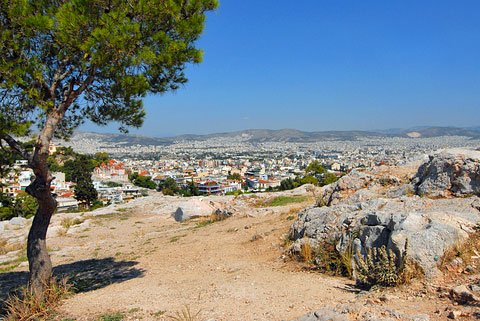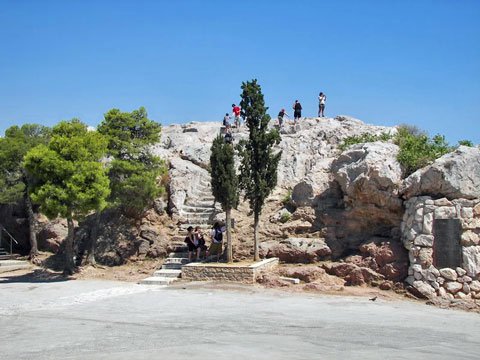The Areopagus, or Hill of Ares, is just to the west as you leave the Acropolis. It was important to the Athenians for a number of reasons.
Myth
One myth tells how the Amazons, who were Theseus’ enemies, camped on the hill and dedicated it to Ares, the god of war.
The 5thC BC playwright Aeschylus in his tragic play ‘The Eumenides’, tells the story of Orestes. Orestes was the son of Agamemnon, the leader of the Greeks in the Trojan war. When Agamemnon returned from the war, his wife Clytemnestra murdered him. In revenge for his father’s death, Orestes killed his mother.
The trial of Orestes took place on the Areopagus. The goddess Athena stood up for him and he was acquitted. He was protected from vengeance by the ‘Furies’, who became known as the Erinyes.

History
Before the 5th century BC, this was the place where the elders of the city held their council. It was much like the Roman Senate. You could only be a member of this council if you held public office, and only then if it was of a specified level of importance, such as Archon.
This continued until 462 BC, when Ephialtes put through reforms which deprived the Areopagus of almost all its functions. The only power it was left with was to hold murder tribunals. In classical times, it functioned as the chief homicide court of Athens.
At the foot of the hill was a temple dedicated to the Erinyes. In many parts in the ancient Greek world, they designated places where murderers could find sanctuary. This temple was one of these places of sanctuary.
A famous courtesan
In 375 BC a famous courtesan called Phryne who was a friend (and model) of the sculptor Praxiteles, was charged with impiety. The trial was held here, and she was acquitted.

St Paul in Athens
Reference is made in the book of Acts in the Bible to the time in AD50 when the apostle Paul spoke to the men of Athens on Mars Hill, the Roman name for the site. The Greeks were very careful not to offend any of the deities, so they had an inscription dedicated to an “unknown god”. St Paul told them that the Christian God was the one they ignorantly worshipped.
On the north side of the hill are the remains of an old church which was originally dedicated to the first people in Athens who had been converted by St Paul. You can also see a bronze plaque which contains the relevant text from the Bible.
A good viewpoint
One reason to climb the hill is for the views. To the north you can see most of Athens, to the west lies the Aegean sea and the port of Piraeus, while back to the east is a clear view of the Propylaia on the Acropolis.
Travel Tip
Be very careful when you walk up the marble steps to the top of the hill. They are well worn through centuries of use, and in wet weather can be very slippery!